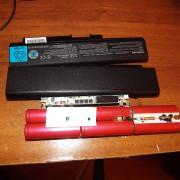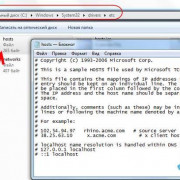RF Wireless World
Содержание:
History
Norman Abramson, a professor at the University of Hawaii, developed the world’s first wireless computer communication network, ALOHAnet, using low-cost ham-like radios. The system included seven computers deployed over four islands to communicate with the central computer on the Oahu Island without using phone lines.

54 Mbit/s WLAN PCI Card (802.11g)
WLAN hardware was initially so expensive that it was only used as an alternative to cabled LAN in places where cabling was difficult or impossible. Early development included industry-specific solutions and proprietary protocols, but at the end of the 1990s these were replaced by standards, primarily the various versions of IEEE 802.11 (in products using the Wi-Fi brand name). An alternative ATM-like 5 GHz standardized technology, HiperLAN/2, has so far not succeeded in the market, and with the release of the faster 54 Mbit/s 802.11a (5 GHz) and 802.11g (2.4 GHz) standards, almost certainly never will.[] Since 2002 there has been newer standard added to 802.11; 802.11n which operates on both the 5Ghz and 2.4Ghz bands at 300 Mbit/s, most newer routers including those manufactured by Apple Inc. can broadcast a wireless network on both wireless bands, this is called dualband. A HomeRF group was formed in 1997 to promote a technology aimed for residential use, but disbanded at the end of 2002.
Wireless LAN WLAN.
There are different network infrastructures (wired LAN, Service Provider Networks) that allow mobility, but in a business environment, the most important is the wireless LAN (WLAN).
Most modern business networks rely on switch-based LANs for day-to-day operation inside the office.
Productivity is no longer restricted to a fixed work location or a defined time period. People now expect to be connected at any time and place, (you are in when you are out…) from the office to the airport or even the home.
Wireless LAN and Wired (Ethernet) LAN
Wireless LANs share a similar origin with Ethernet LANs. The IEEE has adopted the 802 LAN/MAN portfolio of computer network architecture standards. The two dominant 802 working groups are 802.3 Ethernet and 802.11 wireless LAN. However, there are important differences between the two.
WLANs use radio frequencies (RF) instead of cables at the Physical layer and MAC sub-layer of the Data Link layer. In comparison to cable, RF has the following characteristics:
- RF does not have boundaries, such as the limits of a wire in a sheath. The lack of such a boundary allows data frames traveling over the RF media to be available to anyone that can receive the RF signal.
- RF is unprotected from outside signals, whereas cable is in an insulating sheath. Radios operating independently in the same geographic area but using the same or a similar RF can interfere with each other.
iii. RF transmission is subject to the same challenges inherent in any wave-based technology, such as consumer radio. For example, as you get further away from the source, you may hear stations playing over each other or hear static in the transmission. Eventually, you may lose the signal altogether.
Wired LANs have cables that are of an appropriate length to maintain signal strength.
- RF bands are regulated differently in various countries. The use of WLANs is subject to additional regulations and sets of standards that are not applied to wired LANs.
WLANs connect clients to the network through a wireless access point (AP) instead of an Ethernet switch.
WLANs connect mobile devices that are often battery powered, as opposed to plugged-in LAN devices. Wireless network interface cards (NICs) tend to reduce the battery life of a mobile device.
WLANs support hosts that contend for access on the RF media (frequency bands). 802.11 prescribes collision-avoidance instead of collision-detection for media access to proactively avoid collisions within the media.
WLANs use a different frame format than wired Ethernet LANs. WLANs require additional information in the Layer 2 header of the frame.
WLANs raise more privacy issues because radio frequencies can reach outside the facility.
802.11 wireless LANs extend the 802.3 Ethernet LAN infrastructures to provide additional connectivity options. However, additional components and protocols are used to complete wireless connections.
In an 802.3 Ethernet LAN, each client has a cable that connects the client NIC to a switch. The switch is the point where the client gains access to the network.
In a wireless LAN, each client uses a wireless adapter to gain access to the network through a wireless device such as a wireless router or access point.
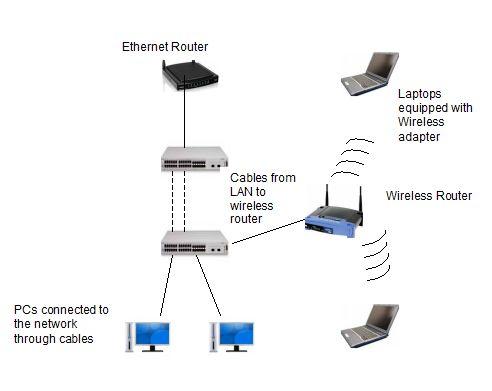
О vlan windows
В Windows vlan не идет как встроенная поддержка. Вы не можете, так из коробки, после установки операционной системы, сказать, что данная сетевая карта будет работать в нужном vlan и задать Vlan ID, НО есть исключения и это специализированные драйвера сетевых карт. Например есть программное обеспечение Realtek Ethernet Diagnostic Utility, как вы можете заметить для сетевых карт Realtek, она то и умеет работать с виртуальными тегами. Карты с поддержкой 802.1Q, так же умеют обрабатывать теги, например могут их удалить или по особому обработать. Не знаю нужен ли вообще для Windows обрабатывать vlan на ее стороне, так как правильнее все это сделать на коммутаторе.
Как правило, в этом случае существуют механизм, позволяющий отключить обработку тегов сетевой картой, сделать её более «тупой» и доставлять трафик вместе с тегами. Обычно, это делается через правку реестра, указанием соответствующего ключа.
Например, для карт Intel в ветке:
HKEY_LOCAL_MACHINE\SYSTEM\ControlSet001\Control\Class\{4D36E972-E325-11CE-BFC1-08002BE10318}\00xx
Ставим значение MonitorModeEnabled= 1
xx — это номер сетевого адаптера в системе, хочу отметить, что у каждого вендора есть свои утилиты и свои драйвера, о их наличии нужно читать спецификацию. Надеюсь, вы не забросите изучение технологии vlan портов и более досконально изучите ее и примените на практике.
Ноя 18, 2014 13:53
-
Последние записи
- Restart-Computer перезагрузка компьютера из PowerShell
- Инструменты управления контроллерами LSI/Avago
- Установка LSI Storage Authority Software, реинкарнация MSM
- Диск с нулевым размеров в ESXI 6.5
- Программа 1cv8c.exe версии прекратила взаимодействие с Windows
Architecture
Stations
All components that can connect into a wireless medium in a network are referred to as stations (STA).
All stations are equipped with wireless network interface controllers (WNICs).
Wireless stations fall into two categories: wireless access points, and clients.
Access points (APs), normally wireless routers, are base stations for the wireless network. They transmit and receive radio frequencies for wireless enabled devices to communicate with.
Wireless clients can be mobile devices such as laptops, personal digital assistants, IP phones and other smartphones, or non-portable devices such as desktop computers, printers, and workstations that are equipped with a wireless network interface.
Basic service set
The basic service set (BSS) is a set of all stations that can communicate with each other at PHY layer.
Every BSS has an identification (ID) called the BSSID, which is the MAC address of the access point servicing the BSS.
There are two types of BSS: Independent BSS (also referred to as IBSS), and infrastructure BSS.
An independent BSS (IBSS) is an ad hoc network that contains no access points, which means they cannot connect to any other basic service set.
Extended service set
An extended service set (ESS) is a set of connected BSSs. Access points in an ESS are connected by a distribution system. Each ESS has an ID called the SSID which is a 32-byte (maximum) character string.
Distribution system
A distribution system (DS) connects access points in an extended service set.
The concept of a DS can be used to increase network coverage through roaming between cells.
DS can be wired or wireless. Current wireless distribution systems are mostly based on WDS or MESH protocols, though other systems are in use.
Applications
Wireless LANs have a great deal of applications. Modern implementations of WLANs range from small in-home networks to large, campus-sized ones to completely mobile networks on airplanes and trains.
Users can access the Internet from WLAN hotspots in restaurants, hotels, and now with portable devices that connect to 3G or 4G networks. Oftentimes these types of public access points require no registration or password to join the network. Others can be accessed once registration has occurred and/or a fee is paid.
Existing Wireless LAN infrastructures can also be used to work as indoor positioning systems with no modification to the existing hardware.
Wireless LAN definition and examples
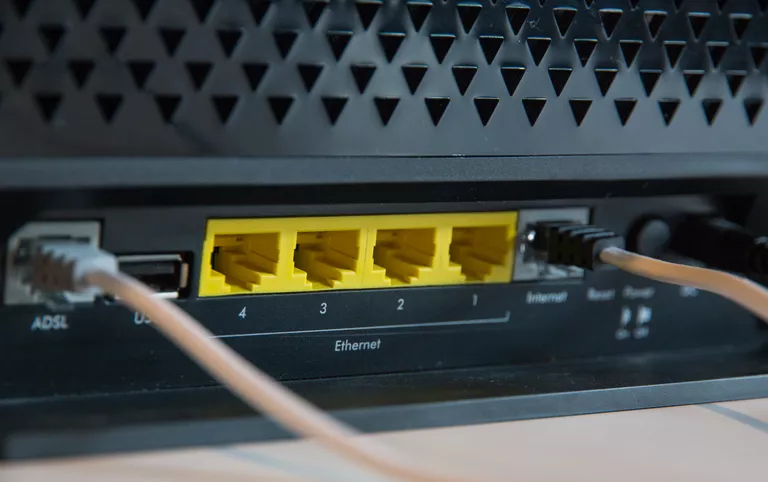
Host Sorter / Unsplash
Internet & Network
-
Key Concepts
-
The Wireless Connection
-
Basics
-
Guides & Tutorials
-
Installing & Upgrading
-
Tips & Tricks
-
What Are Bitcoins?
by
Bradley Mitchell
An MIT graduate who brings years of technical experience to articles on SEO, computers, and wireless networking.
Updated June 24, 2019
68
68 people found this article helpful
A wireless local area network (WLAN) provides wireless network communication over short distances using radio or infrared signals instead of traditional network cabling.
What Does WLAN Mean?
WLAN means wireless local area network.
A WLAN can be built using any of several different wireless network protocols, most commonly either Wi-Fi or Bluetooth.
Network security remains an important issue for WLANs. Wireless clients usually must have their identity verified (a process called authentication) when joining a wireless LAN. Technologies like WPA raise the level of security on wireless networks to rival that of traditional wired networks.
WLAN Pros and Cons
Pros
-
A large number of devices are supported.
-
It’s easy to set up a WLAN, especially when compared to laying cables for wired networks.
-
Accessing a WLAN is easier than a wired LAN since cable length isn’t a factor.
-
WLANs are common even when away from a business or home, like in public areas.
Cons
-
It’s easier to hack a WLAN, which is why encryption is necessary.
-
Wireless interference can hijack the speed and stability of a wireless network.
-
More wireless devices, like repeaters, are needed to expand a wireless network.
Wireless local area networks definitely have their advantages, but we shouldn’t overlook the downfalls.
WLAN Devices
A WLAN can contain as few as two devices up to one hundred and more. However, wireless networks become increasingly difficult to manage as the number of devices increases.
Wireless LANs can contain many different kinds of devices, including:
-
Mobile phones
-
Laptop and tablet computers
-
Internet audio systems
-
Gaming consoles
-
Any other internet-enabled home appliance or device
WLAN Hardware and Connections
WLAN connections work via radio transmitters and receivers built into client devices. Wireless networks don’t require cables, but several special purpose devices (also possessing their own radios and receiver antennas) are usually used to build them.
Local Wi-Fi networks, for example, can be constructed in either of two modes: ad-hoc or infrastructure.
Wi-Fi ad-hoc mode WLANs consist of peer-to-peer direct connections between clients with no intermediate hardware components involved. Ad-hoc local networks can be useful to make temporary connections in some situations, but they don’t scale to support more than a few devices and can also pose security risks.
A Wi-Fi infrastructure mode WLAN, on the other hand, utilizes a central device called a wireless access point (AP) that all clients connect to. In home networks, wireless broadband routers perform the functions of an AP plus enable the WLAN for home internet access. Multiple APs can be interfaced to either and connect multiple WLANs into a larger one.
Some wireless LANs exist to extend an existing wired network. This type of WLAN is built by attaching an access point to the edge of the wired network and set up the AP to work in bridging mode. Clients communicate with the access point through the wireless link and can reach the Ethernet network through the AP’s bridge connection.
WLAN vs. WWAN
Cell networks support mobile phones connecting over long distances, a type of so-called wireless wide area networks (WWAN). What distinguishes a local network from a wide network are the usage models they support along with some rough limits on physical distance and area.
A local area network covers individual buildings or public hotspots, spanning hundreds or thousands of square feet. Wide area networks cover cities or geographic regions, spanning multiple miles.
Continue Reading
History
Norman Abramson, a professor at the University of Hawaii, developed the world’s first wireless computer communication network, ALOHAnet. The system became operational in 1971 and included seven computers deployed over four islands to communicate with the central computer on the Oahu island without using phone lines.
54 Mbit/s WLAN PCI Card (802.11g)
Wireless LAN hardware initially cost so much that it was only used as an alternative to cabled LAN in places where cabling was difficult or impossible. Early development included industry-specific solutions and proprietary protocols, but at the end of the 1990s these were replaced by standards, primarily the various versions of IEEE 802.11 (in products using the Wi-Fi brand name). Beginning in 1991, a European alternative known as HiperLAN/1 was pursued by the European Telecommunications Standards Institute (ETSI) with a first version approved in 1996. This was followed by a HiperLAN/2 functional specification with ATM influences[citation needed] accomplished February 2000. Neither European standard achieved the commercial success of 802.11, although much of the work on HiperLAN/2 has survived in the physical specification (PHY) for IEEE 802.11a, which is nearly identical to the PHY of HiperLAN/2.
In 2009 802.11n was added to 802.11. It operates in both the 2.4 GHz and 5 GHz bands at a maximum data transfer rate of 600 Mbit/s. Most newer routers are able to utilise both wireless bands, known as dualband. This allows data communications to avoid the crowded 2.4 GHz band, which is also shared with Bluetooth devices and microwave ovens. The 5 GHz band is also wider than the 2.4 GHz band, with more channels, which permits a greater number of devices to share the space. Not all channels are available in all regions.
A HomeRF group formed in 1997 to promote a technology aimed for residential use, but it disbanded at the end of 2002.
Примеры использования VLAN
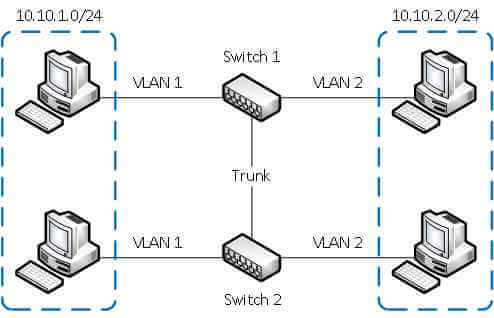
Что такое VLAN-01
Разделение в разные подсети компьютеров, подключенных к одному коммутатору. На рисунке компьютеры физически подключены к одному свитчу, но разделены в разные виртуальные сети VLAN 1 и VLAN 2. Компьютеры из разных виртуальных подсетей будут невидимы друг для друга.
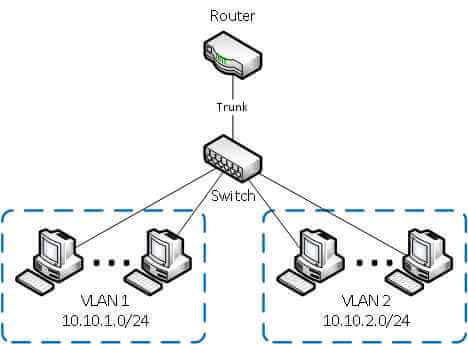
Что такое VLAN-02
Разделение гостевой Wi-Fi сети и Wi-Fi сети предприятия. На рисунке к роутеру подключена физически одна Wi-Fi точка доступа. На точке созданы две виртуальные Wi-Fi точки с названиями HotSpot и Office. К HotSpot будут подключаться по Wi-Fi гостевые ноутбуки для доступа к интернету, а к Office — ноутбуки предприятия. В целях безопасности необходимо, чтобы гостевые ноутбуки не имели доступ к сети предприятия. Для этого компьютеры предприятия и виртуальная Wi-Fi точка Office объединены в виртуальную локальную сеть VLAN 1, а гостевые ноутбуки будут находиться в виртуальной сети VLAN 2. Гостевые ноутбуки из сети VLAN 2 не будут иметь доступ к сети предприятия VLAN 1.

Что такое VLAN-03
Architecture
Stations
All components that can connect into a wireless medium in a network are referred to as stations. All stations are equipped with wireless network interface controllers (WNICs). Wireless stations fall into one of two categories: access points, and clients. Access points (APs), normally routers, are base stations for the wireless network. They transmit and receive radio frequencies for wireless enabled devices to communicate with. Wireless clients can be mobile devices such as laptops, personal digital assistants, IP phones and other smartphones, or fixed devices such as desktops and workstations that are equipped with a wireless network interface.
Basic service set
The basic service set (BSS) is a set of all stations that can communicate with each other. There are two types of BSS: Independent BSS (also referred to as IBSS), and infrastructure BSS. Every BSS has an identification (ID) called the BSSID, which is the MAC address of the access point servicing the BSS. An independent BSS (IBSS) is an ad-hoc network that contains no access points, which means they can not connect to any other basic service set. An infrastructure can communicate with other stations not in the same basic service set by communicating through access points.
Extended service set
An extended service set (ESS) is a set of connected BSSs. Access points in an ESS are connected by a distribution system. Each ESS has an ID called the SSID which is a 32-byte (maximum) character string.
Distribution system
A distribution system (DS) connects access points in an extended service set. The concept of a DS can be used to increase network coverage through roaming between cells.
DS can be wired or wireless. Current wireless distribution systems are mostly based on WDS or MESH protocols, though other systems are in use.
Types of wireless LANs
Peer-to-peer
Peer-to-Peer or ad-hoc wireless LAN
An ad-hoc network is a network where stations communicate only peer to peer (P2P). There is no base and no one gives permission to talk. This is accomplished using the Independent Basic Service Set (IBSS).
A peer-to-peer (P2P) network allows wireless devices to directly communicate with each other. Wireless devices within range of each other can discover and communicate directly without involving central access points. This method is typically used by two computers so that they can connect to each other to form a network.
If a signal strength meter is used in this situation, it may not read the strength accurately and can be misleading, because it registers the strength of the strongest signal, which may be the closest computer.
Hidden node problem: Devices A and C are both communicating with B, but are unaware of each other
IEEE 802.11 defines the physical layer (PHY) and MAC (Media Access Control) layers based on CSMA/CA (Carrier Sense Multiple Access with Collision Avoidance). The 802.11 specification includes provisions designed to minimize collisions, because two mobile units may both be in range of a common access point, but out of range of each other.
The 802.11 has two basic modes of operation: Ad hoc mode enables peer-to-peer transmission between mobile units. Infrastructure mode in which mobile units communicate through an access point that serves as a bridge to a wired network infrastructure is the more common wireless LAN application the one being covered. Since wireless communication uses a more open medium for communication in comparison to wired LANs, the 802.11 designers also included shared-key encryption mechanisms: Wired Equivalent Privacy (WEP), Wi-Fi Protected Access (WPA, WPA2), to secure wireless computer networks.
Bridge
A bridge can be used to connect networks, typically of different types. A wireless Ethernet bridge allows the connection of devices on a wired Ethernet network to a wireless network. The bridge acts as the connection point to the Wireless LAN.
Wireless distribution system
Main article: Wireless Distribution System
A Wireless Distribution System enables the wireless interconnection of access points in an IEEE 802.11 network. It allows a wireless network to be expanded using multiple access points without the need for a wired backbone to link them, as is traditionally required. The notable advantage of WDS over other solutions is that it preserves the MAC addresses of client packets across links between access points.
An access point can be either a main, relay or remote base station. A main base station is typically connected to the wired Ethernet. A relay base station relays data between remote base stations, wireless clients or other relay stations to either a main or another relay base station. A remote base station accepts connections from wireless clients and passes them to relay or main stations. Connections between «clients» are made using MAC addresses rather than by specifying IP assignments.
All base stations in a Wireless Distribution System must be configured to use the same radio channel, and share WEP keys or WPA keys if they are used. They can be configured to different service set identifiers. WDS also requires that every base station be configured to forward to others in the system.
WDS may also be referred to as repeater mode because it appears to bridge and accept wireless clients at the same time (unlike traditional bridging). It should be noted, however, that throughput in this method is halved for all clients connected wirelessly.
When it is difficult to connect all of the access points in a network by wires, it is also possible to put up access points as repeaters.
WLAN vs Ethernet LAN difference between WLAN and Ethernet LAN
This page on WLAN vs Ethernet LAN describes difference between WLAN and Ethernet LAN.
This difference between WLAN(Wireless LAN) and Wired LAN is very useful to have comparison between them.
The figure-1 below depicts wlan or wireless LAN network.
It operates on radio frequency 2.4 GHz or 5.8 GHz or both as per IEEE 802.11 specifications.
There are various WLAN versions viz. 802.11a, 11b, 11g, 11n, 11ac and 11ad etc.
Latest WLAN versions incorporate multiple antenna based MIMO techniques to provide support for higher
data rates.Refer 11n vs 11ac vs 11ad
and 11a vs 11b vs 11g vs 11n for more information.

The figure-2 below depicts ethernet lan network. Refer Ethernet types such as
ethernet, fast ethernet and gigabit ethernet.
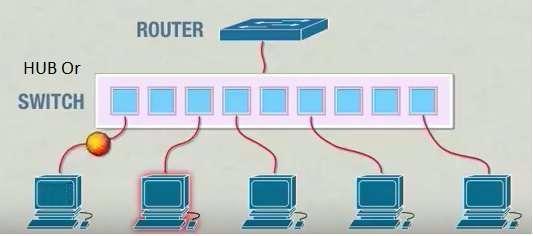
Let us summarize core difference between wlan and ethernet LAN types.
| WLAN | Ethernet LAN |
|---|---|
| The WLAN devices are based on IEEE 802.11 family of standards. | The Ethernet LAN devices are based on IEEE 802.3 standards. |
| WLAN devices use high energy radio frequency waves to transmit the data. | Ethernet LAN devices use electric signals to transmit the data. |
| Radio frequency waves travel in the space. Hence a physical connection is not needed between the devices which are connected to the WLANs. |
Elctric signals flow over the cables. Hence wired connection is needed between devices which are connected to the Ethernet LANs. |
| WLAN uses half duplex mechanism for communication. | Ethernet supports full duplex mechanism for communication when a switch connects using a single device rather than hub. |
| WLANs suffer from interference of various types during travel from source to the destination. | LANs suffer less interference as electric signals travel using cables. |
| WLANs use CSMA/CA to avoid collisions in the network. | Ethernet LANs use CSMA/CD to detect collisions in the network. |
| Refer WLAN tutorial | Refer IEEE 802.3 ethernet standards |
WLAN and Ethernet LAN Related Links
WLAN tutorial
About wlan
802.11 standards
11a WLAN PHY
11b PHY
11n PHY
WLAN 802.11ac
WLAN 802.11ad
Ethernet over copper
Ethernet Business
Gigabit Ethernet
40Gbps Ethernet PHY
100Gbps Ethernet PHY
10Gbps Ethernet PHY
Ethernet types
What is Difference between
hub Vs switch
circuit switching Vs packet switching
firewall Vs router
HDLC Vs PPP
IGRP Vs EIGRP
router Vs bridge
switch Vs router
WLAN Vs Ethernet LAN
LAN vs WAN vs MAN
Translate this page
ARTICLES
T & M section
TERMINOLOGIES
Tutorials
Jobs & Careers
VENDORS
IoT
Online calculators
source codes
APP. NOTES
T & M World Website
Roaming
Roaming among Wireless Local Area Networks
There are two definitions for wireless LAN roaming:
- Internal roaming: The Mobile Station (MS) moves from one access point (AP) to another AP within a home network if the signal strength is too weak. An authentication server (RADIUS) performs the re-authentication of MS via 802.1x (e.g. with PEAP). The billing of QoS is in the home network. A Mobile Station roaming from one access point to another often interrupts the flow of data among the Mobile Station and an application connected to the network. The Mobile Station, for instance, periodically monitors the presence of alternative access points (ones that will provide a better connection). At some point, based on proprietary mechanisms, the Mobile Station decides to re-associate with an access point having a stronger wireless signal. The Mobile Station, however, may lose a connection with an access point before associating with another access point. In order to provide reliable connections with applications, the Mobile Station must generally include software that provides session persistence.
- External roaming: The MS (client) moves into a WLAN of another Wireless Internet Service Provider (WISP) and takes their services (Hotspot). The user can use a foreign network independently from their home network, provided that the foreign network allows visiting users on their network. There must be special authentication and billing systems for mobile services in a foreign network.[clarification needed][citation needed]
Что такое Wi-fi и WLAN
Wi-Fi — это современная, одна из
самых перспективных на сегодняшний день беспроводная технология
передачи данных по радиоканалу. Технология Wi-Fi предоставляет
свободу перемещения, как в пределах одной комнаты, так и по
всему миру, с высокоскоростным доступом ко всем ресурсам
локальной сети офиса и Интернет с КПК, ноутбука, карманного
компьютера, Web-камеры или беспроводного IP-телефона в зоне
покрытия сети Wi-Fi через так называемые точки доступа или
хотспоты. Wi-Fi обеспечивает пользователям мобильных ПК больше
возможностей для работы и развлечений вне дома или офиса: в
гостиницах, аэропортах, кафе и других местах, оснащенных точками
доступа стандарта Wi-Fi.
Wi-Fi
обычно произносится как , но правильно
говорить . Wi-Fi сокращенно от английского
словосочетания «Wireless Fidelity», в переводе с английского
языка означает — точная беспроводная передача данных,
беспроводная преданность, в беспроводном ключе. Технологией
Wi-Fi так же называют протокол и стандарт IEEE 802.11(a-r) (диапазон
2,4 ГГц и 5 ГГц) на оборудование для широкополосной радиосвязи,
предназначенной для организации локальных беспроводных сетей
Wireless Local Area Network (WLAN). Логотип Wi-Fi обозначает
совместимость конкретного изделия с сетями WLAN, но если на
компьютере есть логотип Intel Centrino, он уже полностью готов
для работы с Wi-Fi и никакие дополнительные устройства не нужны.
Что такое Wireless Local Area Network (WLAN)?
WLAN — это вид локальной вычислительной сети, использующий для
связи и передачи данных между узлами высокочастотные радиоволны,
а не кабельные соединения. Установка таких сетей рекомендуется
там, где монтаж кабельной сети невозможен или экономически
нецелесообразен. Благодаря функции хендовера пользователи могут
перемещаться между точками доступа по территории покрытия сети
Wi-Fi без разрыва соединения. Это гибкая система передачи данных,
которая применяется как расширение или альтернатива кабельной
локальной сети внутри одного офиса, здания или в пределах
определенной территории. Wi-Fi позволяет экономить средства за
счет отсутствия необходимости прокладывания кабеля, а простота
установки не отнимает время на сложные монтажные работы.
Расширение и реконфигурация сети WLAN не является сложной
задачей, пользовательские устройства можно интегрировать в сеть,
установив на них беспроводные сетевые адаптеры. Беспроводные
сети используют радиочастоты, поскольку радиоволны внутри
помещения проникают через стены и перекрытия. Диапазон или
область охвата большинства систем WLAN достигает 160 м, в
зависимости от количества и вида встреченных препятствий.
Беспроводные сети обычно более надежны, чем кабельные.
Скорость работы сравнима со скоростью кабельной сети. Точно так
же, как и в обычной сети, пропускная способность сети WLAN
зависит от ее топологии, загрузки, расстояния до точки доступа и
т.д. Количество пользователей практически неограниченно. Его
можно увеличивать, просто устанавливая новые точки доступа. С
помощью перекрывающихся точек доступа, настроенных на разные
частоты (каналы), беспроводную сеть можно расширить за счет
увеличения числа пользователей в одной зоне. Технология Wi-Fi
обеспечивает одновременную работу в сети нескольких десятков
активных пользователей, скорость передачи информации для
конечного абонента может достигать 108 Мбит/с.
В операционной системе Windows постоянно работают невообразимо огромное количество разных служб и сервисов, которые, в свою очередь, регулируют и контролируют работу компьютера. Каждая служба занимается своим делом и координирует определенные процессы, происходящие в операционной системе. В этой статье мы разберем, что такое служба автонастройки WLAN (WLANSVC), а также где и как ее включить.


